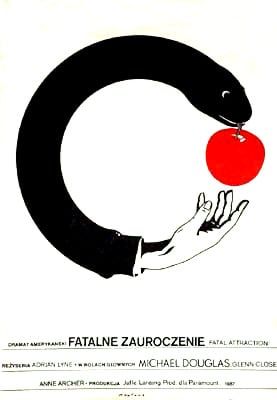Polish Film Posters Show Off New Side of Cinema, Fetch Big Bucks

The Cold War had some interesting side effects, and one of the most compelling stories could be found in the strange balance between the State's begrudging acceptance of Western cinema as art and wholehearted rejection of its commercial trappings. The result was the limited release of Western European and American films but with absolutely no trace of their marketing campaigns.
Poland, of all places, had an interesting take on generating publicity for these films--in 1946, Film Polski (the State-run film distributor and only legal film distributor in the country) hired renowned polish artists Henryk Tomaszewski, Tadeusz Trepkowski and Eryk Lipinski as graphic designers to create poster art for a series of posters, both imported and domestic.
For the better part of fifty years, Western European and American films were reinterpreted via Polish poster-art. The works range from the sublime and inspired (Cabaret) to the straight-up knock-off (Terminator) to the vaguely disturbing (Raiders of the Lost Ark) to the actually disturbing (Terms of Endearment). Say what you will of the end results, but it's hard to argue that these radical reinterpretations serve as sharp reminders of what it's like to occasionally separate marketing from art, and to respond to a work of cinema through imagery built to evoke the tones and feelings found in the movies themselves.
As a film geek with a day job in live theater, it's hard to not draw parallels between the worldwide art scenes at the time of some of these posters' creations; in the late sixties and early seventies, there's a burst of surrealism and psychedelic elements, with punk and even cyberpunk influences finding their ways in in the eighties. On Polish cinema walls, you could find a reflection of the cutting-edge styles you'd see in galleries worldwide, mashed up against pop culture.
Another curious parallel to live theater marketing is the occasional abstractness of these--they tend to look like the movies feel, not intertwined to what they may look like or who they star. It's a strong testament to the strength of emotional impressionism.
Ultimately the fall of the Berlin Wall ended the Polish State's monopoly on film distribution, and when Warner, Paramount and the rest of the major studios made inroads into the country, with them came the traditional marketing plans. Today these posters are worth several hundred to several thousand dollars on the secondary market; occasionally, some of the Polish artists who made their names producing these posters produce gallery-specific, limited-run prints for current films, which fetch similar prices.
It's a great story, and a fascinating reminder of how inspiring and--even without marketing dollars--how ever-present cinema is in worldwide culture. Check out CNN's coverage of this phenomenon here, and take a peek at six of my favorites, below.
CINEMABLEND NEWSLETTER
Your Daily Blend of Entertainment News






Most Popular






